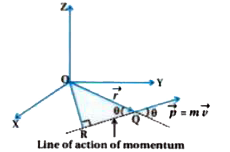Explain linear and angular momentum. Solution in Gujrati
Just as the moment of a force is the rotational analogue of force, the quantity angular momentum is the rotational analogue of linear momentum.
In figure, Q is a particle of mass m, having position vector in Cartesian co-ordinate system.

is the linear velocity of the particle. So its linear momentum is .
Here it is not necessary that the particle Q should be of a rigid body and it should move over a curved path.
Let the angle between be .
The vector product or is defined as the angular momentum of the particle w.r.t. point O.
Unit of angular momentum is or J.S and dimensional is
The magnitude of depends on the selection of the reference point and so while defining the angular momentum of a particle it is necessary to mention the reference point.
The direction of can be obtained with the help of right handed screw rule. Here is in OZ direction.
Now .
Angular momentum of a particle = (magnitude of linear momentum (the perpendicular distance) of linear momentum (vector) from the reference point.
This relation also be written as under
where , it is perpendicular distance from origin to line of action of is the velocity component of momentum perpendicular to the position vector.
Topper's Solved these Questions
- BOOK - KUMAR PRAKASHANCHAPTER - SYSTEMS OF PARTICLES AND ROTATIONAL MOTIONEXERCISE - SECTION-A HOTS3videos
SYSTEMS OF PARTICLES AND ROTATIONAL MOTION
- BOOK - KUMAR PRAKASHANCHAPTER - SYSTEMS OF PARTICLES AND ROTATIONAL MOTIONEXERCISE - SECTION-A (TRY YOURSELF (VSQs))94videos
SYSTEMS OF PARTICLES AND ROTATIONAL MOTION
- BOOK - KUMAR PRAKASHANCHAPTER - QUESTIONS ASKED IN JEE - 2020 EXERCISE - Question16videos
QUESTIONS ASKED IN JEE - 2020
- BOOK - KUMAR PRAKASHANCHAPTER - THERMAL PROPERTIES OF MATTEREXERCISE - Question Paper (Section - D) (Answer following in brief :) Each carry 4 marks1videos
THERMAL PROPERTIES OF MATTER
Similar Questions
What is torque? Explain the torque acting on a particle.
02:36View SolutionWhat is a rigid body ? Explain the differences between rigid body and solid body.
00:52View SolutionA non-isotropic solid metal cube has coefficient of linear expansion as 5×10−5/∘C along the x-axis and 5×10−6/∘C along y-axis and z-axis. If the coefficient of volumetric expansion of the solid is n×10−6/∘C then the value of n is....
04:22View SolutionIn an experiment on the specific heat of a metal, a 0.20 kg block of the metal at 150∘C is dropped in a copper calorimeter (of water equivalent 0.025 kg) containing 150 cm3 of water at 27∘C. The final temperature is 40∘C. Compute the specific heat of the metal. If heat losses to the surroundings are not negligible, is your answer greater or smaller than the actual value for specific heat of the metal ?
03:42View SolutionA wave transmits linear momentum. Can it transfer angular momentum?
02:21View SolutionThe dimensions of the ratio of angular momentum to linear momentum is
02:52View Solutionकोणीय व रेखीय संवेगो के अनुपात की विमाये हैं :
01:46View Solutionरेखीय संवेग का कौन-सा घटक कोणीय संवेग उत्पन्न नही करता?
02:35View SolutionThe angular momentum L, the linear momentum P and position vector 'r' are related as
02:25View SolutionHow is angular momentum related to linear momentum ?
02:27View SolutionRepresent angular momentum of a particle in terms of linear momentum in a vector form.
01:57View SolutionMention the relation between linear momentum and angular momentum with usual meanings.
03:24View Solutionकोणीय संवेग का z घटक रेखिक संवेग के घटकों के रूप में अग्र है -
05:42View SolutionWhat is the vector relation of linear momentum and angular momentum ?
00:53View SolutionIf the linear momentum and angular momentum are zero, then the object is said to be in
02:48View Solutionकथन:- किसी उपग्रह का कोणीय संवेग संरक्षित रहता है।
कारण :- रेखीय संवेग संरक्षण से कोणीय संवेग संरक्षण पर पहुँचा जा सकता है।06:38View Solution
